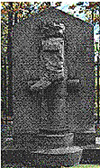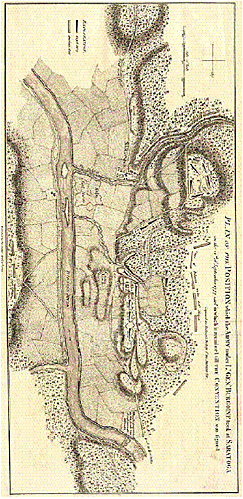Finally Burgoyne resumed his advance. He ordered his remaining six thousand men south, crossing to the West Bank of the Hudson River on September 13th. On the 19th he ordered his army forward in a reconnaissance of the American positions.
The advance was made in three columns, General Fraser his most accomplished commander led the left, Burgoyne the center and the German, von Riedesel, the right. The British advanced and the American scouts reported it. At this point the Americans had two choices aptly given in the following:
- "Burgoyne's men had slept on their arms for several nights, expecting an attack in force from the Americans, for the active Arnold, with about fifteen hundred men, had annoyed the British continually, by sudden assaults at night.".
"Gates, who lacked personal courage and the skill of a good commander, had resolved to act on the defensive within his own lines."
The American's choice was either to meet the attack or await it. To come to the correct answer one must analyze the opponents. Burgoyne it should be remembered had been at Boston and observed the British attacks on Breed's Hill. The losses of this action resulted in so many British casualties that one British General keenly observed, "One more victory like this will destroy the British Army".
Burgoyne was the first to coin the phrase "Rabble in Arms", yet he recognized that the rebels' fortification defense at Breed's Hill was "well thought out". He wrote at the time, the rebels' were, "so adept in constructing fortifications" and behind which "they fought with tenacity that in the future only artillery" would be able dislodge them without a horrific loss of men. It was for this reason that he had insisted a complete artillery train accompany his army in the invasion of New York.
Why did Arnold, who had advised Gates on the need for fortifications and helped select the site, prefer to meet the British advance in the field and surrounding woods rather than at the walls of the defense itself? Perhaps Arnold was concerned at what the reaction of these part time American soldiers would be after a day or two of continuous artillery barrages by Burgoyne's cannon without any ability to strike back. Would they break and run?
It is a moot point, for Arnold, at first with Gates assumed permission then over his objections, led his Division into a day long action against the British. First sent in were Morgan's and his trusted Riflemen. These were men who had been under Arnold's command during his invasion of Canada. In all, Arnold would order and lead seven regiments into the battle. Arnold commanded the field, he led the charges and rallied the troops. He begged Gates for reinforcements. Finally, he returned to headquarters in a lull in the battle to plead in person. Gates' refused and ordered Arnold to remain in camp.
At the end of the day Burgoyne held the field while the Americans returned to their lines. As to who was the victor the casualty count tells it all. Burgoyne's losses, killed and wounded at six hundred and twenty, were double the three hundred inflicted on the Americans.
Burgoyne was "victorious" but trapped. On September 18th, one day before Freeman's Farm, John Brown, a Continental Colonel, and five hundred soldiers successfully attacked and captured a British outpost at the foot of Lake George. This forcedestroyed two hundred boats, captured three hundred British soldiers, and freed one hundred American prisoners. The limb Burgoyne had climbed out on was now totally severed.
On October 6th, Burgoyne made a decision. The lateness of the season, the lack of food for his army already on half rations with only three weeks of supply remaining left him little choice. Either he would reach Albany or if that were not possible he would begin an attempt to return to Canada on October 11th. Led by his most able commanders fifteen hundred men selected from his army began a reconnaissance in an effort to find a way around the American force.
Morgan's' riflemen and three thousand New York Regulars immediately challenged the British. The British advance was stopped their line broken and most of their artillery lost. They attempted to form a second line when Arnold, an observer without a command, ignored Gates orders, and atop a large black horse charged into the fray to lead three regiments of his old command in an assault. One of many he would lead that day.
Arnold and Morgan were the fire and sword of the American effort at the second battle of Saratoga. On the British side there was only one. Their catalyst was General Simon Fraser, a truly outstanding officer and man. It was General Fraser who rallied the British forces and who was bringing order out of chaos when Arnold spotted his actions. Arnold told Morgan that Fraser had to be eliminated. Morgan called his men together and gave orders to a file of his best marksmen: "That gallant officer is General Fraser. I admire and honor him, but it is necessary that he should die; victory for the enemy depends on him. Take your stations in that clump of bushes, and do your duty."
Timothy Murphy one of Morgan's sharpshooters mortally wounded Fraser a few minutes later. If the loss of General Fraser was not enough three thousand fresh New York Militia appeared on the field at which the ensuing British retreat became a general rout. Arnold followed up the British retreat by first leading an assault on the British Balcarres redoubt. In this he was unsuccessful, it being too heavily defended. Then he spied another opportunity and led a successful coordinated attack on the nearby Breymann's redoubt. According to contemporaneous accounts Arnold in the lead, still mounted on the black charger, leapt the wall followed by his men who breached the gate. Here he was shot in the leg below the knee, the bullet passed into his horse which collapsed and broke his leg. Arnold's last official battlefield command was that his men should spare the German who fired the shot. It again was his left leg, the same leg in which he had received the wound in Quebec.
Summary
What then did Benedict Arnold contribute to the two battles at Saratoga, which many historians feel was America's most critical victory in its history? First without the delay imposed by Arnold the previous year on the British with his scratched up fleet on Lake Champaign the British would have kicked off their campaign of 1777 at least as far south as Fort Ticonderoga if not at Fort Edward. The ramifications of British control of northern New York from the autumn of 1776 to the spring of 1777 are incalculable.
Arnold was also the only officer to answer General Schuyler's call for a volunteer at a crisis point when Burgoyne's advance from the north coincided with a deadly threat to Albany from the east by St. Ledger. Arnold accomplished this relief through subterfuge and without loss to his men and against a superior force. Returning from his success at Fort Stanwick, Arnold was one of the two major players who convinced his new Commander, General Gates, to reposition his army in a more appropriate defensive position and then selected it for him.
At the first battle of Saratoga, Arnold was the General on the field who brought in the victory. Again it was Arnold who having been relieved of command, effectively assumed leadership of the American army in the field and once again brought it victory. (If anyone knows of another case of this type I would love to hear of it -- JMF). Gates, the American commander, was in his usual position two miles to the rear. While Gates sat out the battle, Arnold's leadership led to the destruction of the most significant force the British had yet fielded in North America.
It was all over for Burgoyne and his army. He had no choice but to surrender on October 16th. Arnold's capture of the Breymann's redoubt had left all remaining strong points indefensible. Burgoyne attempted a retreat and failed.
Repercussions Of The Victory At Saratoga
On November 1st, a fast sailing ship left Boston Harbor for France with the news of Burgoyne's surrender. By December 4th, Benjamin Franklin had received the dispatch and by December 6th, the King of France Louis XVI approved an alliance with America. Within sixty six days America as a result of that one victory at Saratoga gained by Arnold had won the sponsorship of the French Government -- the only country capable of challenging Britain.
In February 1778 France actively entered the war. As a result it was the French Navy, which finally helped end the war when it foiled the British Navy's attempt to support Cornwallis who was under siege by American and French troops. Cornwallis was forced to surrender in the last action of the American Revolution and it was all brought about by Arnold's victory at Saratoga.
Final Thoughts
- The evil that men do lives after them, The good is oft' interned with their bones.
Arnold's destiny was to turn himself from one of the great heroes of the American Revolution into the epitome of traitorousness. Some of the seeds of his treachery were planted during his recuperation from his leg wound at Saratoga. Arnold started to become embittered by what he saw as a lack of recognition for his military genius on the part Congress and the Continental Army. Just a year and a half after his gallantry at Saratoga, Arnold offered his services to the British. Specifically, he planned to hand over the keys to West Point, a crucial American fort on the Hudson which Arnold commanded.
The plot quickly unraveled. Arnold's contact with the British army, Major John Andre, was captured by American forces with letters implicating Arnold in his boot. Andre was hanged. Arnold escaped to the British on a frigate called Vulture---one vulture receiving another, Thomas Paine wrote in one of his Crisis papers. Arnold went on to command British forces against American troops in his native Connecticut. The dichotomy of feeling for Benedict Arnold, the hero and patriot and Benedict Arnold the traitor was best expressed by an American officer he captured there.
 "What would be my fate if I should be taken prisoner by the Americans?" the former patriot asked.
"What would be my fate if I should be taken prisoner by the Americans?" the former patriot asked.
The officer replied:
-
"They will cut off that leg of yours wounded at Quebec and Saratoga and bury it with all the honors of war. Then they will hang the rest of you on a gallows!"
If you visit the Saratoga battlefield today, you will find -- at the place where Arnold was wounded -- a small statue of a leg. It bears no name.
Map

Battle of Saratoga
Simon Fraser
We Have Met The Enemy and He Is Us
Why Build a Road Through the Wilderness?
Ticonderoga's Fatal Flaw
Three British Generals
Battle of Saratoga Jumbo Map (very slow: 349K)
More Benedict Arnold
- Part 1: Early Activities
Part 2: Invasion of Canada
Part 3: The Battle of Valcour Island
Part 4: Prelude to Saratoga
Part 5: Battle of Saratoga
Back to Cry Havoc #28 Table of Contents
Back to Cry Havoc List of Issues
Back to MagWeb Master Magazine List
© Copyright 1999 by David W. Tschanz.
This article appears in MagWeb (Magazine Web) on the Internet World Wide Web. Other military history articles and gaming articles are available at http://www.magweb.com